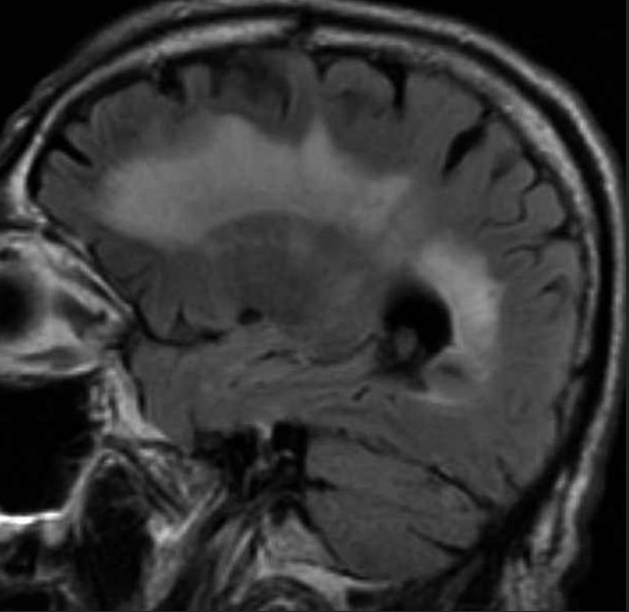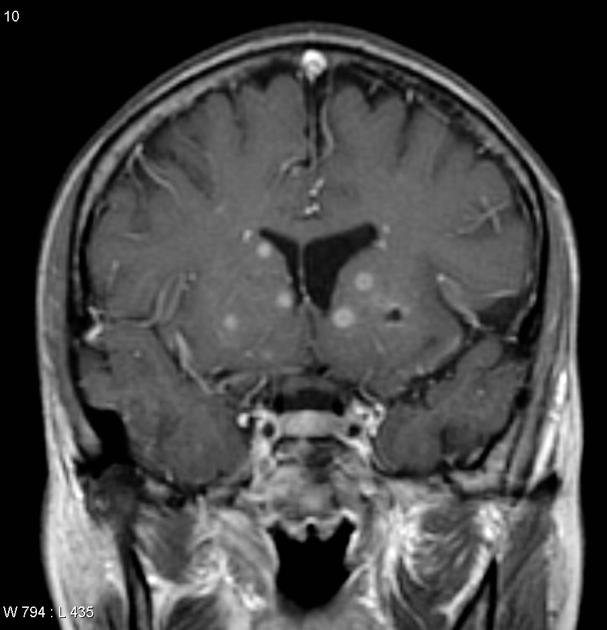HIV AIDS MRI
|
AIDS Microchapters |
|
Diagnosis |
|
Treatment |
|
Case Studies |
|
HIV AIDS MRI On the Web |
|
American Roentgen Ray Society Images of HIV AIDS MRI |
Editor-In-Chief: C. Michael Gibson, M.S., M.D. [4]; Associate Editors-in-Chief: Ujjwal Rastogi, MBBS; Ammu Susheela, M.D. [5]
Overview
Magnetic resonance imaging is the neuroimaging modality of choice for the work-up of HIV-positive patients with suspected CNS disease. MRI can aid in the diagnosis of primary CNs lymphoma, AIDS dementia complex, and cerebral toxoplasmosis. AIDS-Dementia complex is characterized by diffuse cerebral atrophy, enlargement of the cerebral ventricles, and diffuse white matter hypoattenuation. Cerebral toxoplasmosis demonstrates ring enhancing lesions with surrounding edema that mayy closely resemble primary CNS lymphoma.
MRI
Advantages of MRI over CT in AIDS diagnosis
- Much more sensitive than CT scan in determining if a lesion is truly solitary.
- Greater sensitivity for white matter disease.
- Greater sensitivity for lesions in the posterior fossa.[1]
- Helps in identifying a peripheral lesion which is more accessible for histological sampling, in case a biopsy is being considered.[2]
 |
Toxoplasmosis
- Lesions may appear hyperintense or isointense depending on the type of infection.
- In necrotising encephalitis due to Toxoplasma, the MRI findings will be hyperintense.
- If the lesion is an abscess, the MRI will show isointense characteristics.
- Most of the time the lesions are surrounded by edema
- If contrast is used, the MRI will show the characteristic ring enhancement lesions.
 |
 |
References
- ↑ Skiest DJ (2002). "Focal neurological disease in patients with acquired immunodeficiency syndrome". Clin. Infect. Dis. 34 (1): 103–15. doi:10.1086/324350. PMID 11731953. Retrieved 2012-02-12. Unknown parameter
|month=ignored (help) - ↑ Whiteman ML, Post MJ, Berger JR, Tate LG, Bell MD, Limonte LP (1993). "Progressive multifocal leukoencephalopathy in 47 HIV-seropositive patients: neuroimaging with clinical and pathologic correlation". Radiology. 187 (1): 233–40. PMID 8451420. Retrieved 2012-02-12. Unknown parameter
|month=ignored (help)
- Pages with citations using unsupported parameters
- CS1 maint: Multiple names: authors list
- HIV/AIDS
- Disease
- Immune system disorders
- Viral diseases
- Pandemics
- Sexually transmitted infections
- Syndromes
- Virology
- AIDS origin hypotheses
- Medical disasters
- Immunodeficiency
- Microbiology
- Emergency mdicine
- Up-To-Date
- Infectious disease